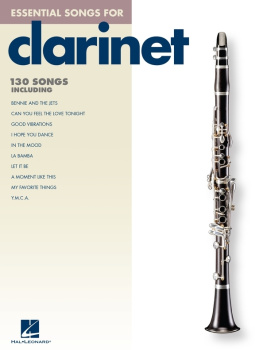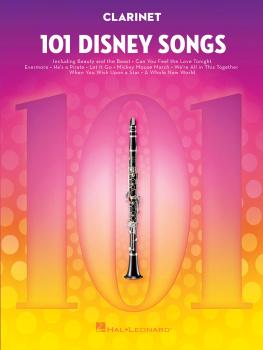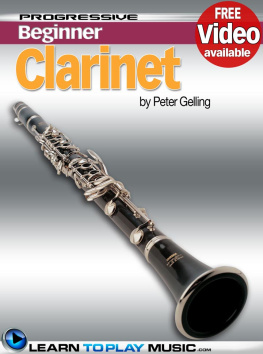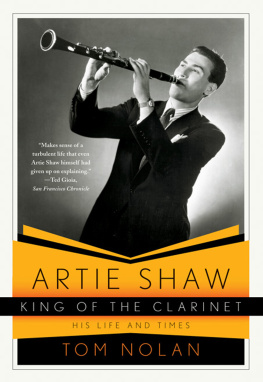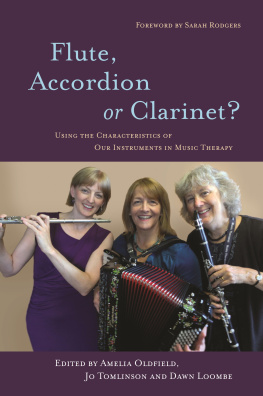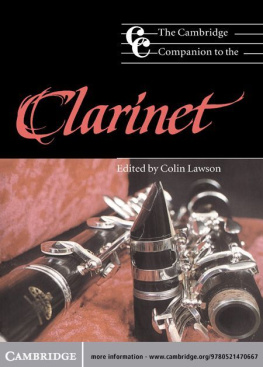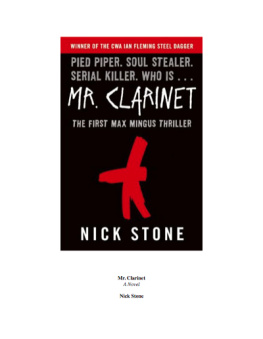THE CLARINET
AND
CLARINET PLAYING

DAVID PINO
DOVER PUBLICATIONS, INC.
Mineola, New York
Copyright
Copyright 1980 by David Pino
All rights reserved.
Bibliographical Note
This Dover edition, first published in 1998, is an updated but otherwise unabridged republication of the work originally published by Charles Scribners Sons, New York, 1983. References to manufacturers and suppliers of instruments and accessories have been made current wherever possible, and entries in the bibliography have been corrected as well.
The excerpt from Musical Instruments Through the Ages, edited by Anthony Baines, copyright 1961, 1966, 1969 Penguin Books, is used with the permission of Penguin Books and Walker and Company.
Library of Congress Cataloging-in-Publication Data
Pino, David.
The clarinet and clarinet playing / David Pino.
p. cm.
Originally published: New York : C. Scribners Sons, 1980.
This Dover edition... is an updated but otherwise unabridged republication... References to manufacturers and suppliers of instruments and accessories have been made current... and entries in the bibliography have been correctedVerso of t.p.
Includes bibliographical references (p. ) and index.
eISBN 13: 978-0-486-17383-2
1. ClarinetInstruction and study. I. Title.
MT380.P56 1998
788.6219dc21
98-44312
CIP
MN
Manufactured in the United States by Courier Corporation
40270306
www.doverpublications.com
FOR
KEITH STEIN,
the master clarinetist and teacher
who inspired this book in more ways
than he has imagined,
AND FOR
MY STUDENTS,
who teach me more than they know
Acknowledgments

The ideas as presented in this book are my own, but I have drawn them from many sourcesfrom teachers and students, from books, from friends, from my own experience.
There has been no way for me to avoid frequent mention of the words and the approaches to clarinet playing of Keith Stein, the great clarinetist to whom, along with my students, this book is dedicated. Although several men have had a significant influence on twentieth-century clarinet playing, Stein must be ranked among the most influential of all. I acknowledge his contribution to the book.
It is customary for author-husbands to thank their wives and children for their patience in putting up with the process of writing, and such thanks are certainly in order here. My wife, Carol, and our sons, Aaron and Nathan, have helped me immensely, too, through their patience and interest.
My good friend and colleague Dr. Byron Wolverton has offered me much encouragement and advice. His fine dissertation on Early American keyboard music has sparked my interest in the Early American clarinetwhich remains a wide field for further study.
My thanks go to Susanne Kirk, my editor at Charles Scribners Sons, without whose helpand patience, pleasantness, and encouragementthe book could never have been written. Jacques Barzun, Literary Advisor at Scribners, has my gratitude, too, for his help and encouragement.
For the photographs in , Reeds, I am indebted to my friend David Herbert, who is also a fine oboist and a fellow member of the San Marcos Woodwind Quintet.
To my mind, the greatest experimenters of all are open-minded students, andas a teacherI have been blessed with many. To all my students I give my thanks.
I might add that this book was not the result of a grant or a leave of absence from my teaching position; I had not asked for such. Nor was I forced to write by a publish-or-perish situationI was under no such pressure. The book was written because of concerns that will be mentioned in the Introduction and because Keith Stein had been urging me for some time to write my own book on the clarinet.
Finally, much of this book was written here in my study in a fine old Texas-German farmhouse with a wonderful breeze coming in through the windows from across the fields; I feel that the book has been immeasurably helped by being created in such surroundings. My shepherd dog Hilda has been at my feet, wondering when I would stop this infernal tapping and go play with her outdoors, where she believes I belong...
D AVID P INO , D.M.A.
San Marcos, Texas
Contents


Introduction

I wrote this book because of my great concern that information about the clarinet should be more widely available. Also, I have long felt that the clarinet and clarinet playing should be better understood on all levelsnot merely at the beginning and intermediate levels. Too many advanced clarinetists and clarinet teachers have been holding out on the rest of us, guarding trade secrets to an alarming degree, or at least withholding them through neglect. Interestingly, perhaps one of the most closely guarded trade secrets of all is the fact that the more advanced a player becomes, the more he or she must rely on the basic and fundamental principles that are, or should be, taught to beginners. Beginners are urged to use more air, to develop a better embouchure, to relax the arms and fingers, and so onthe very advice that should be given to the professional clarinetist when faced with a particularly difficult passage.
Another concern that led to this book is my belief that many myths about clarinet playing should be struck down. I have attempted not only to do this, but also to replace the myths with constructive alternatives. Nowhere, for instance, have I seen any full discussion of the possibility of adopting a truly workable technique for the double and triple tonguing that would seem natural on the clarinet. The type of multiple tonguing used by brass and flute players who have no mouthpiece or reed in their mouths is not adequate on clarinet in the long run. I have provided an alternative technique in , Tonguing and Articulation. All tonguing strokes on the clarinetwhether single, double, or triplemust be done on the reed itself.
Similarly, despite the increasing cost and decreasing strengths of commercially made clarinet reeds, nowhere have I discovered a recent, fully adequate description of the making of reeds by hand. Some earlier, and valuable, work was done in reed making by the clarinetist Kalmen Opperman and others, but I believe that I have devised a more direct, less complicated method for making reeds than any I have read about elsewhere.
The tone qualities of American clarinetists in particular are, I feel, becoming smaller and harsher through a combination of several factors; I have attempted to alleviate this problem by offering a variety of possible causes and solutions.
I believe that there is today a need to revolutionize, if possible, the common conception of what it means to practice the clarinet. I have seen too many clarinet studentsand professionals, as wellalmost beating their heads against the practice room walls, and I cannot let this pass without comment and without offering, again, a constructive solution. I feel that both students and teachers should approach the clarinet with a sense of humor because, otherwise, both learning and instructing become emotionally and physically overwhelming.


